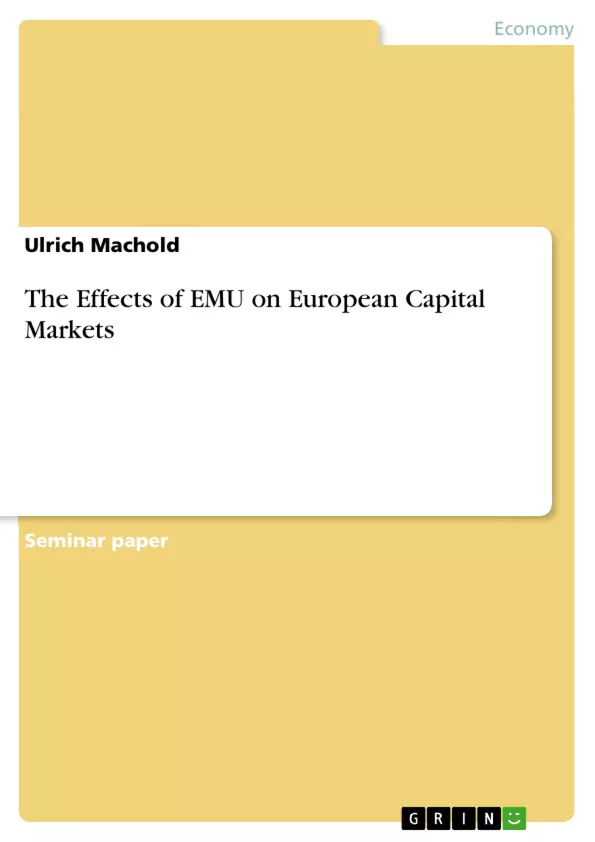Within the last three years, the European financial landscape has undergone a rapid transformation that continues to astonish observers and market participants alike: Corporate and public euro bond markets have emerged whose issuing activities rival those of respective US dollar markets. Europe-wide indices have been firmly established. Institutional portfolios are being traded along pan-European sectoral rather than national lines. Cross-border mergers of banks and financial institutions on an unprecedented scale are drastically changing national banking landscapes as well as international financial structures and underlying all of this is the revolutionary emergence of a genuine European equity culture.
Quite naturally, not all of these developments can be attributed to the eventual arrival of European Economic and Monetary Union (EMU). Many trends have had their precursors in the continuing liberalisation and de-regulation processes of the 1990s, as manifested in the 1992 Maastricht Treaty. However, historical data makes it difficult not to account for EMU as one major factor behind many of the most recent changes.
In this paper, I will therefore argue that at least some of the above changes can best be explained by the effects of EMU. In several ways, the advent of the single currency has triggered an equilibrium shift in more than one field that would otherwise not have occurred. In order to do so, I shall first put EMU into perspective by briefly sketching its position within the wider framework of the process of European capital market integration by means of liberalisation. Second, I shall illustrate whether and to what extent the intended direct effects of EMU did in fact materialise, but also how further indirect effects go beyond these and contribute to explaining some seemingly less related developments. Last, I shall evaluate how integrated European capital markets in fact are compared to national markets, using the U.S. as a benchmark, and close with a brief discussion of potential normative implications.
Inhaltsverzeichnis (Table of Contents)
- Introduction
- European Capital Market Integration
- 1987 and the Single European Act
- Maastricht and Beyond
- The Effects of EMU on Capital Markets
- The Direct Effects of EMU
- Standardisation and Price Transparency
- Shrinking of Foreign Exchange Markets
- Elimination of Currency Risk
- Homogenisation of Refinancing Procedures
- The Indirect Effects of EMU
- Market-Depth and Liquidity
- The Public Bond Market
- The Private Bond Market
- Market-Breadth and Diversification
- Banking and Financial Market Institutions
- Market-Depth and Liquidity
- The Direct Effects of EMU
- One Market?
- The Cost of Intra-European Investing
- Banking Structure
- Economic Barriers
- Home Bias
- Conclusion
Zielsetzung und Themenschwerpunkte (Objectives and Key Themes)
This paper examines the impact of the European Economic and Monetary Union (EMU) on European capital markets. It analyzes the direct and indirect effects of the single currency on market integration, market depth, and liquidity. The paper also explores the extent to which a truly integrated European capital market has emerged, comparing it to the U.S. market as a benchmark.
- The impact of EMU on European capital market integration
- The direct and indirect effects of the single currency
- The emergence of a truly integrated European capital market
- Comparison of the European capital market to the U.S. market
- Potential normative implications of EMU on capital markets
Zusammenfassung der Kapitel (Chapter Summaries)
The paper begins by providing a historical overview of the process of European capital market integration, highlighting key milestones such as the 1987 Single European Act and the 1992 Maastricht Treaty. It then delves into the effects of EMU, examining both its direct effects on market standardization, price transparency, and currency risk reduction, as well as its indirect effects on market depth, liquidity, and diversification.
The paper further explores the extent to which European capital markets are integrated compared to national markets, examining factors such as the cost of intra-European investing, banking structure, and home bias. It concludes by providing a brief discussion of potential normative implications.
Schlüsselwörter (Keywords)
The key keywords and focus topics of the paper include: European Economic and Monetary Union (EMU), European capital market integration, single currency, direct and indirect effects, market depth, liquidity, diversification, home bias, banking structure, and U.S. market comparison.
- Quote paper
- Ulrich Machold (Author), 2001, The Effects of EMU on European Capital Markets, Munich, GRIN Verlag, https://www.grin.com/document/9449



